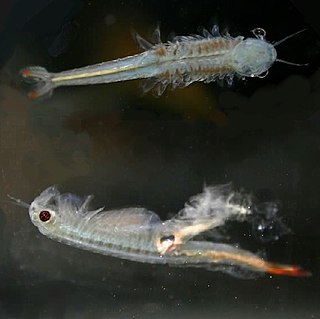
Branchiopoda is a class of crustaceans. It comprises fairy shrimp, clam shrimp, Diplostraca, Notostraca and the Devonian Lepidocaris. They are mostly small, freshwater animals that feed on plankton and detritus.

Anostraca is one of the four orders of crustaceans in the class Branchiopoda; its members are referred to as fairy shrimp. They live in vernal pools and hypersaline lakes across the world, and they have even been found in deserts, ice-covered mountain lakes, and Antarctic ice. They are usually 6–25 mm (0.24–0.98 in) long. Most species have 20 body segments, bearing 11 pairs of leaf-like phyllopodia, and the body lacks a carapace. They swim "upside-down" and feed by filtering organic particles from the water or by scraping algae from surfaces, with the exception of Branchinecta gigas, or "giant fairy shrimp", which is itself a predator of other species of anostracans. They are an important food for many birds and fish, and some are cultured and harvested for use as fish food. There are 300 species spread across 8 families.

Branchinecta is a genus of crustacean in family Branchinectidae. It includes around 50 species, found on all continents except Australia. Branchinecta gigas, the giant fairy shrimp, is the largest species in the order, with a length of up to 10 centimetres (4 in), and Branchinecta brushi lives at the highest altitude of any crustacean, at 5,930 metres (19,460 ft), a record it shares with the copepod Boeckella palustris. A new genus, Archaebranchinecta was established in 2011 for two species previously placed in Branchinecta.
Branchinella apophysata is a species of crustacean in the family Thamnocephalidae. It is endemic to Australia, where it is known only from its type locality, a shallow pool on Mount Margaret, near Laverton, Western Australia. It is most closely related to other Australian species, including B. affinis, B. denticulata, B. latzi, B. longirostris and B. probiscida.

Chirocephalus is a genus of fairy shrimp in the family Chirocephalidae. It contains the following species:
Parartemia contracta is a species of fairy shrimp in the family Parartemiidae and is commonly found in Australia.

Parartemia is a genus of brine shrimp endemic to Australia. One species, P. contracta is listed as vulnerable on the IUCN Red List. Parartemia contains the following species:

Streptocephalus is a genus of fairy shrimp found in temporary waters in Africa, Australia, Eurasia, and Central and North America, following its ancient origin in Gondwana. It contains the following species:
Branchinecta gigas is a species of fairy shrimp that lives in western Canada and the United States. It is the largest species of fairy shrimp, growing up to 86 mm (3.4 in) long. It is known commonly as the giant fairy shrimp.

Chirocephalidae is a family of fairy shrimp, characterised by a reduced or vestigial maxilla, more than two setae on the fifth endite, divided pre-epipodites and widely separated seminal vesicles. It consists of the following eight genera, including the genera formerly placed in the families Linderiellidae and Polyartemiidae:

Dendrocephalus is a genus of fairy shrimp found in South and North America. It is characterised by the presence of an antenna-like appendage arising between the second antennae and the eyestalks. The genus comprises 16 species in two subgenera:

Tanymastix stagnalis is a species of Anostraca that lives in temporary pools across Europe. It may reach up to 2 cm (0.8 in) in some areas and has 11 pairs of bristly, flattened appendages. It swims upside-down and filters food particles from the water. It is the only species of Anostraca in Ireland, having been discovered in Rahasane turlough in 1974.
Linderiella africana is a species of fairy shrimp in the family Chirocephalidae. It is found in Africa.
Branchinecta gaini is a species of fairy shrimp from Antarctica and Patagonia. It is the largest freshwater invertebrate in Antarctica, at 16 mm (0.63 in) long. It lives on bacteria and other organisms, surviving the winter as resting eggs.
Parastreptocephalus is a subgenus of the fairy shrimp genus Streptocephalus, characterised by features of the male antennae and the tetrahedral shape of the eggs. It comprises six species:

Branchinecta paludosa is a species of fairy shrimp with a Holarctic distribution.

Branchipodopsis is a genus of aquatic crustaceans, in the order Anostraca. It is one of several genera known as fairy shrimp. All described species are specialised for inhabiting ephemeral rock pools in situations such as mountains and deserts. Though the genus is most widely known from Africa, some occur in the middle east and adjoining regions.

Streptocephalus sirindhornae is a species of crustacean in the family Streptocephalidae; a genus of freshwater dwelling shrimp belonging to the Anostraca order of Branchiopoda. It is endemic to Thailand, and it was named after Princess Sirindhorn.
Lynceus is a genus of clam shrimp in the family Lynceidae. There are about 13 described species in Lynceus.
Lynceidae is a family of clam shrimp in the order Laevicaudata. There are about 5 genera and more than 20 described species in Lynceidae.











